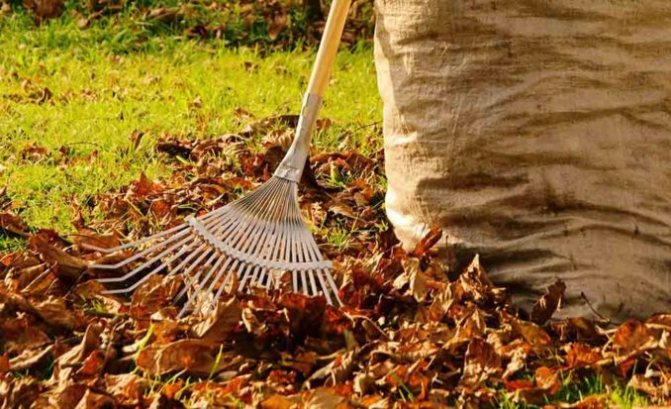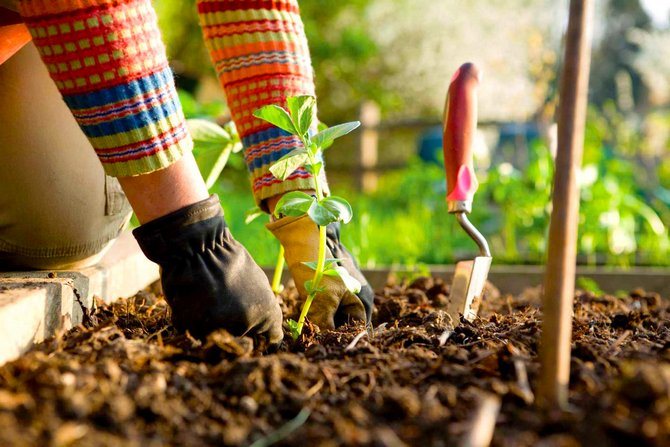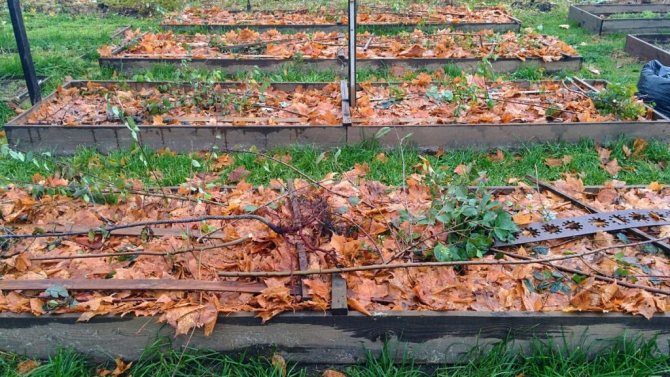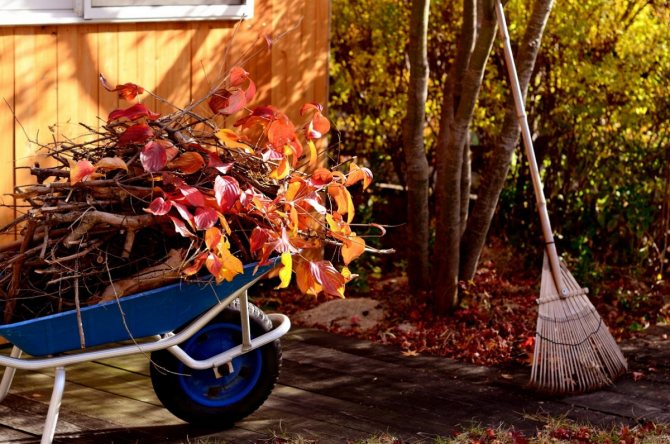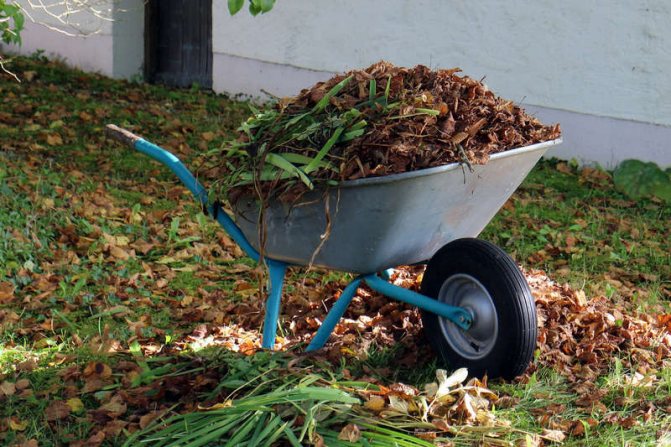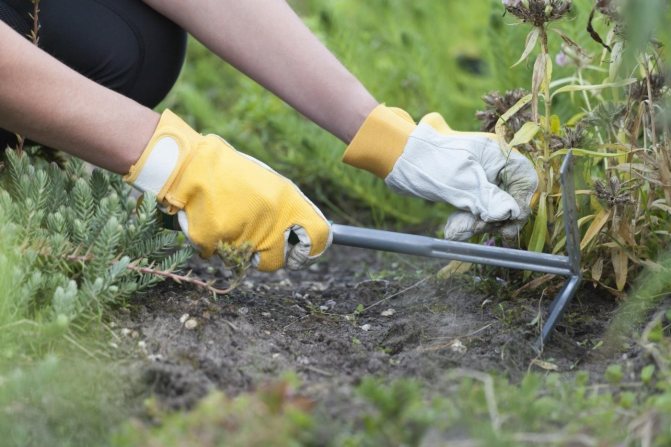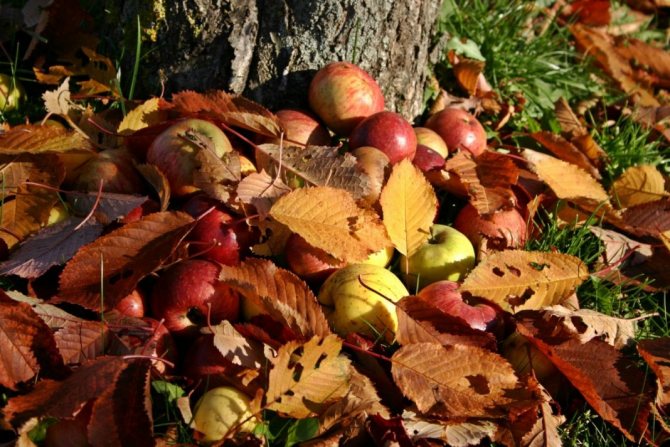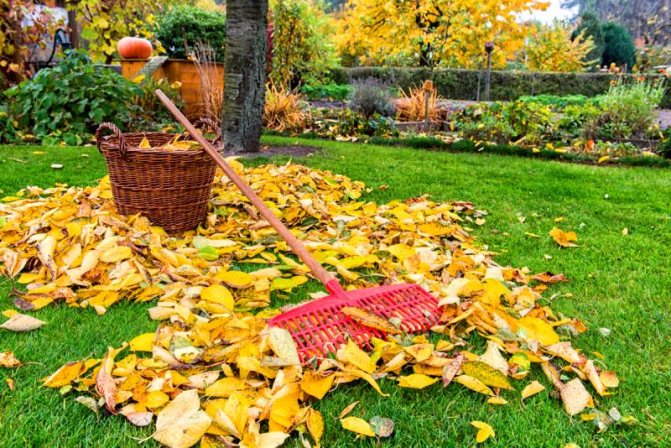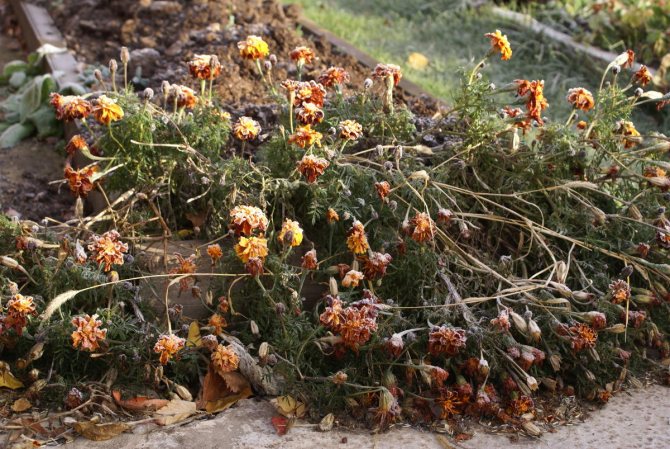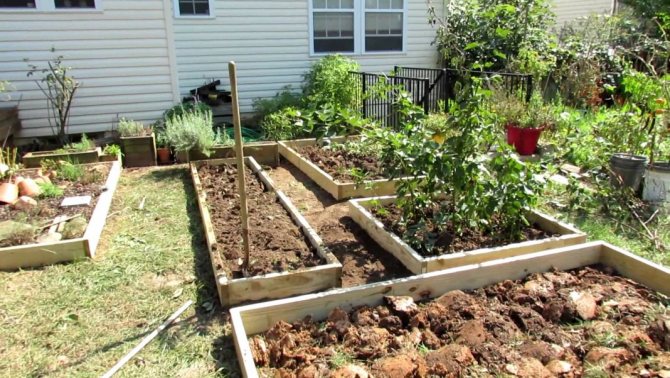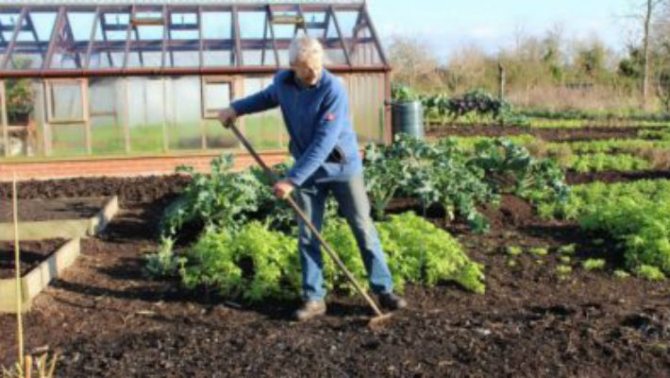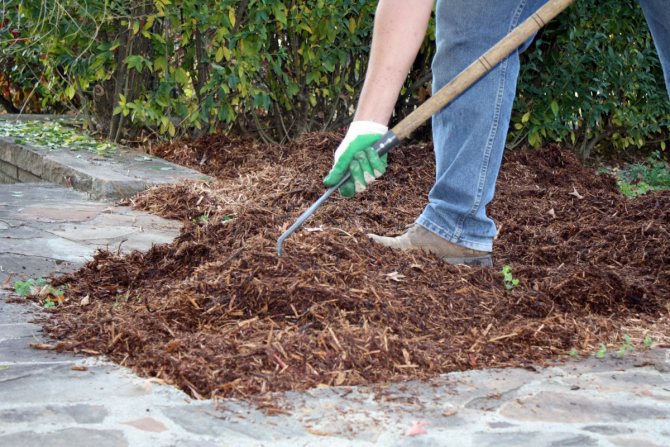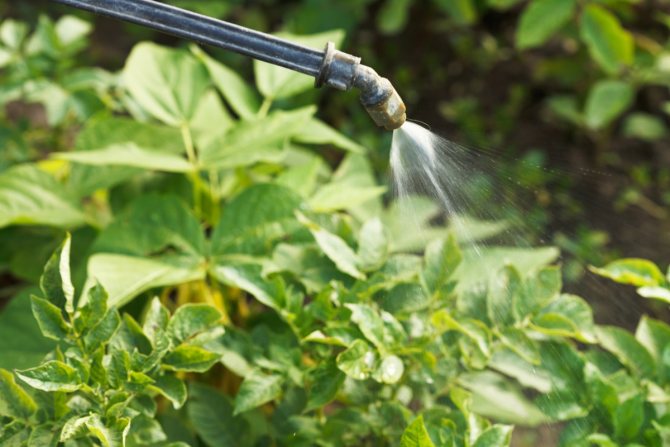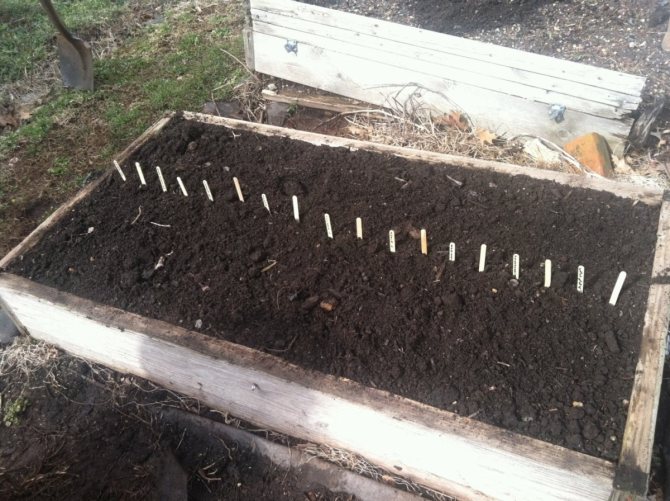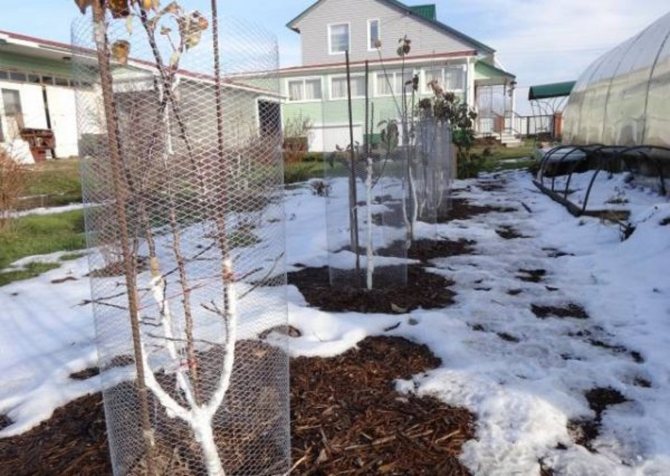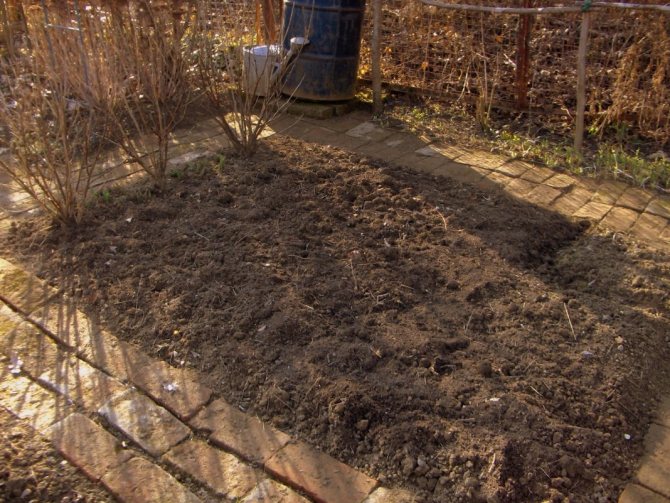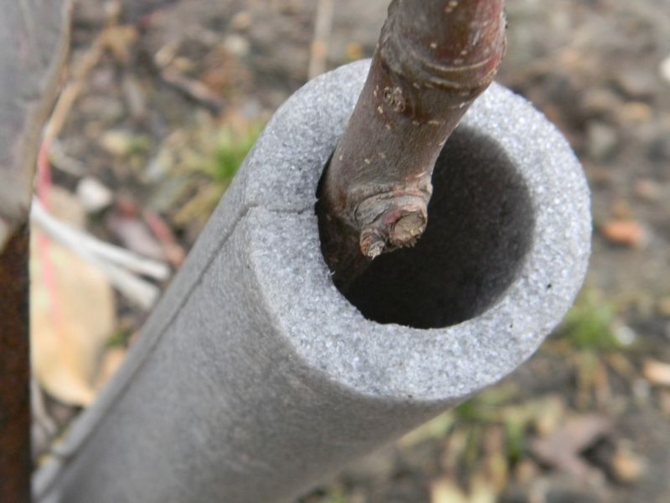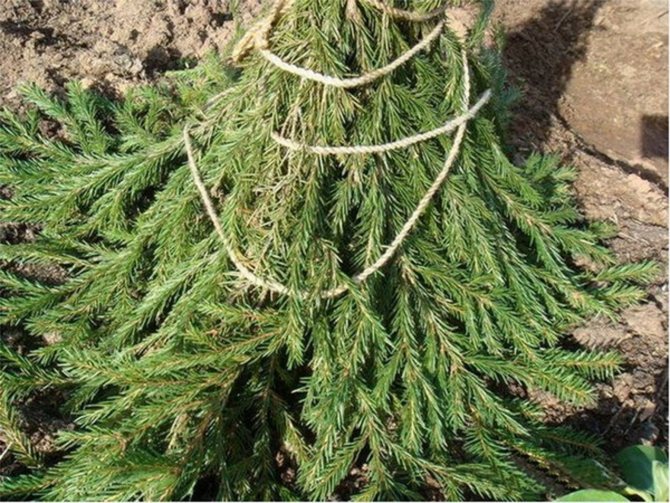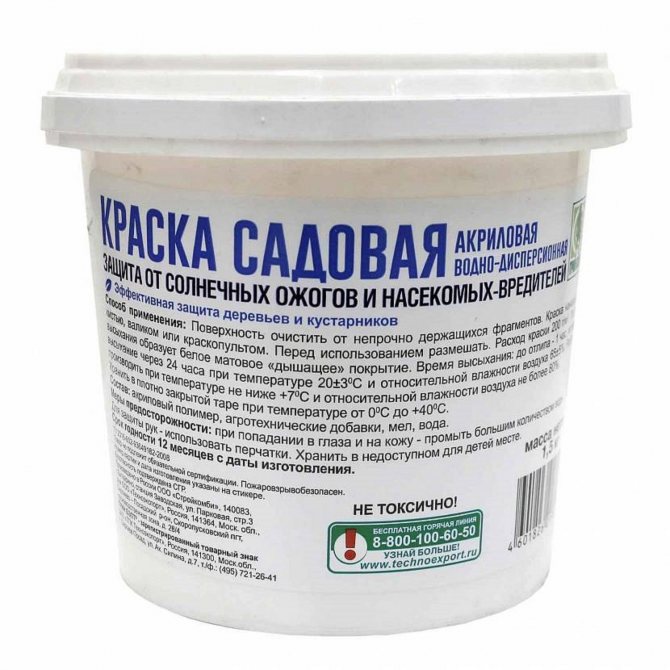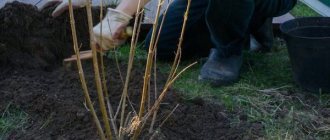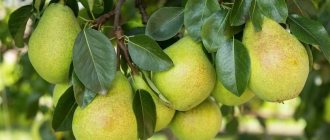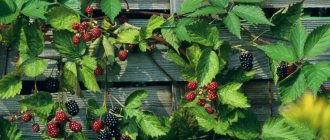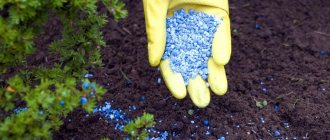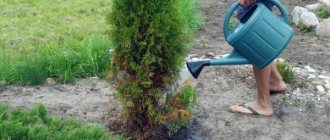Now is the very beginning of autumn, the whole crop has not even been harvested from the site yet. But you may not believe that in order to ensure the next season's harvest, it is time to start preparing the vacated soil for future beds. And this is not a joke at all: you need to prepare this soil not anyhow, but correctly, so as not to be disappointed in the next year's harvest. How to prepare the beds, how to properly dig up and apply fertilizers for the most common vegetable crops right now, we will tell you today.
Autumn preparation of beds in the garden.
It is clear that the formation of the above-ground mass, the formation of a crop that we harvest, consume or store, leads to the removal of various elements from the soil. First of all, it is the well-known nitrogen, phosphorus and potassium. So, immediately after harvesting and when preparing the beds for the new season, it is advisable to make up for the deficiency of these elements in the soil, although it is not visible to the naked eye.
The autumn period is almost an ideal period for applying various kinds of fertilizers, which during the winter time will "reach" the soil, and the plants sown or planted on the beds we have made will begin to consume them already in an accessible form, and not wait until they turn into such, wasting precious time on their development and forcing us to wait longer for the harvest.
For example, organics and various minerals: in fact, any vegetable crops perceive and react to them in a purely positive way. However, in order for the root system to perceive this or that element, it must already be in an accessible, dissolved form, and this takes time. This is exactly the time that winter is.
Of course, when choosing fertilizers, you need to take into account a number of factors - this is the biology of the culture, which in the future will grow in this place, and the type of soil (heavy, sandy soil, black soil, and so on) and even the weather conditions at a given time, which determine including the condition of the soil.
So, there is enough reasoning, we go directly to the rules for preparing the beds in the autumn period for the next season.
Cleaning leaves from the garden
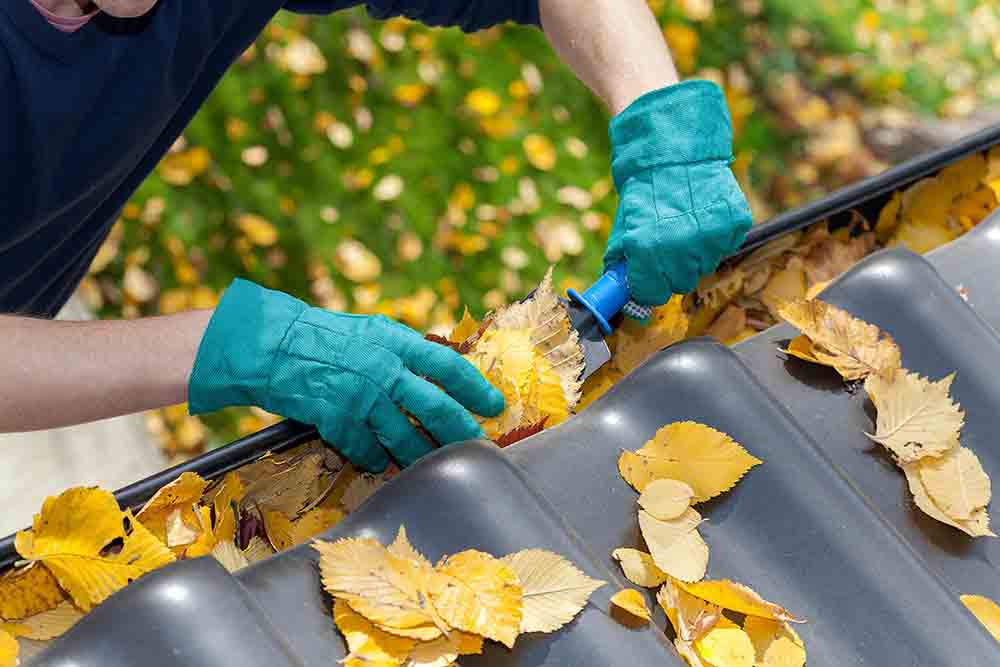
Gather the leaves with a rake. If your shrubs and trees have not been affected by diseases and pests, send the foliage to a compost heap or to warm beds, use as mulch for wintering flowers. But keep in mind: leaves infected with scab, powdery mildew and other diseases are not suitable for this. Take them outside your property and burn them.
Don't forget to remove the leaves from the roofs of all your buildings on the lot!
Preparing flowers for winter in the fall in the garden
All garden perennials need winter preparation. Care depends on the type of plant, type, characteristics, in particular frost resistance. Tuberous flowers (gladioli, tulips, dahlias and others) must be dug up for the winter. The bushes are dug in, the tubers are taken out of the ground, and thoroughly dried. Then it is processed and stored in a cellar or basement.
For other perennials, the top of the plant should be cut off. And cover the bushes with humus to protect them from freezing. This applies to chrysanthemums, host, phlox, peonies and other beautiful flowers. As mulch, you can use not only humus, but also peat, spruce branches, leaves.
Should roses be pruned before winter? Rose is a very capricious flower, and does not like the cold. The rose bushes need to be pruned to make them easier to cover for the winter. Medium pruning is most commonly used. Each shoot leaves 3-5 buds. All damaged shoots and dry twigs are removed. Then the rose bush is wrapped. To do this, you can build a shelter from wooden planks, burlap or other covering material. Some people use special boxes or boxes that cover the bushes.
You may be interested in: Caring for gladioli in the fall, preparing for winter


Pruning trees
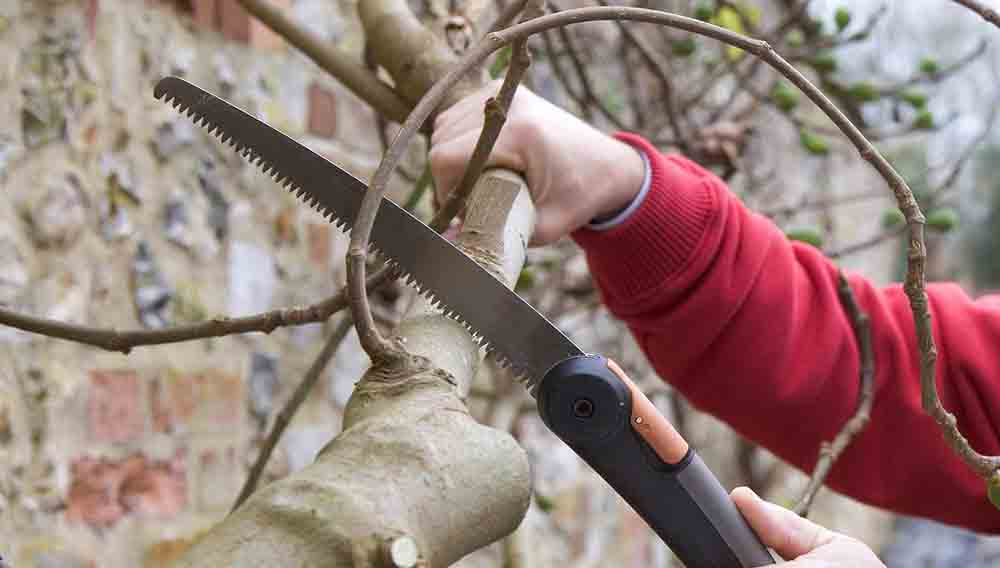

Before the onset of frost in dry weather, it is necessary to prune fruit trees. Using a sharp pruner or a garden saw, you must completely remove dry, damaged, affected and growing in the crown of the branches. After that, the sections must be treated with a solution of copper sulfate at the rate (dissolve 1 tsp of the substance in 1 liter of water) and cover with garden varnish or oil paint.
The importance and significance of autumn care


As soon as the last harvest from trees and shrubs has been collected, it is time to start preparing the garden for wintering. It is necessary to carry out a number of important measures that will increase their winter hardiness, namely:
- strengthening the immune system;
- reducing the volume of the branches;
- protection against diseases, pests;
- top dressing;
- watering, digging;
- whitewashing of trees;
- harvesting leaves.
Such procedures allow plants to withstand severe frosts or harsh thaws. If you skip a stage, then in the spring you will have to make up for everything, and this can cause a lack of harvest or the death of a plant.
Treatment against diseases and pests


After the leaves fall, proceed to the autumn processing of the garden. If you find signs of mold on the trees, spray the plants with a 3% solution of Bordeaux mixture. In order to get rid of the causative agents of coccomycosis, powdery mildew, scab and other common diseases, treat tree crowns with urea at the rate (0.5 kg of urea per 10 liters of water). Also spray the soil around the trees, only with a more concentrated solution at the rate (1 kg of urea per 10 liters of water).
Urea treatment helps to kill pests that winter in the topsoil and on tree branches
In the fight against pests, loosening the soil with a pitchfork in the near-trunk circles to a depth of 20 cm helps. After this procedure, the insect larvae find themselves on the surface of the earth and, accordingly, die during severe frosts.
How to properly prepare a vegetable garden for winter
Finally, it is necessary to tell what to do in the garden in the fall, in addition to the usual cleaning. Those areas where vegetables and other crops grew must be dug up with a pitchfork or a shovel. In this case, it is impossible to break earth lumps.
Some gardeners do not dig up the soil, but simply apply a layer of organic fertilizers to it. You can mulch the soil with grass or needles. Over the winter, all this will rot and become fertilizer. How to prepare a vegetable garden for winter in Siberia? The preparation is no different from the one described above. Open ground is fertilized and dug up. Fruit trees are watered, pruned and fertilized. Flowers are either dug up or covered for the winter.
Autumn tree feeding
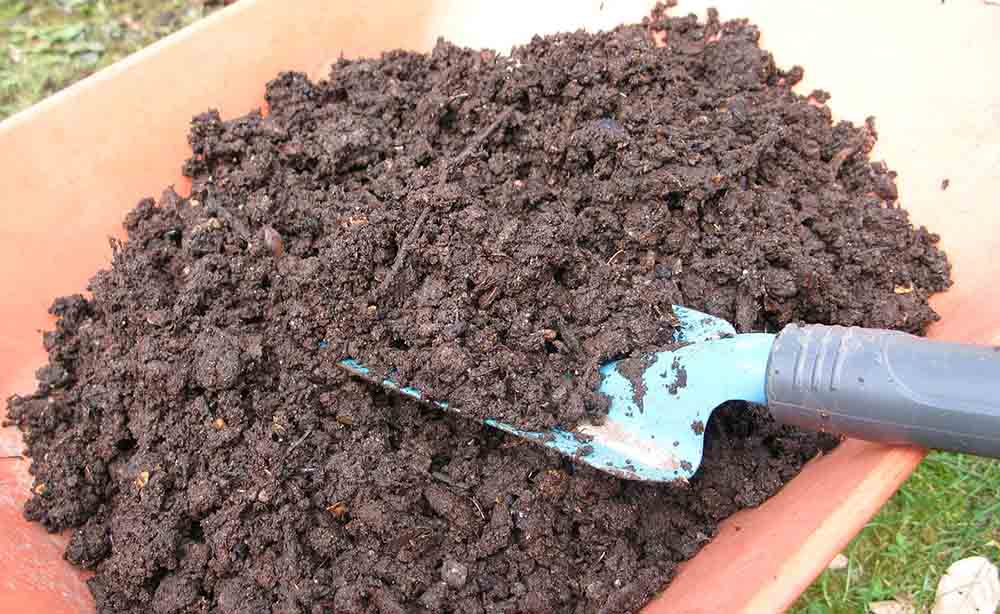

As organic fertilizers at this time of the year, slurry diluted with water in a ratio of 1:10, compost (for trees from 1 to 7 years old - 1.5-2 kg per 1 square meter of trunk circle, for trees over 7 years old) - from 2 to 3 kg), ash at the rate (100 g per 10 liters of water), humus (1/2 bucket per 1 square meter of trunk circle).
In autumn, fruit trees also need mineral fertilizers, with the exception of nitrogen, which activates growth processes that are undesirable at this time and reduces the winter hardiness of plants. In the near-trunk circle of each tree, it is necessary to apply phosphorus-potassium fertilizer.
For trees under 10 years old, per 1 square meter of the trunk circle, spend 2 tablespoons of superphosphate and 1 tablespoon of potassium chloride. Feed trees over 10 years old at the rate of 4 tablespoons of superphosphate and 2 tablespoons of potassium chloride. Cherries and plums, feed 3 tablespoons of superphosphate and 2 tablespoons of potassium sulfate, diluted in 10 liters of water. Use 4 buckets of this fertilizer for every mature tree.
Do I need to mow the lawn before winter
The owners of large country houses with a spacious well-groomed plot often wonder if they need to mow the grass before winter. Preparatory work must begin in mid-September. In the south, the dates may be shifted.
- Watering the lawn stops when the air temperature drops below 5-7 degrees. At this time, the soil already does not absorb moisture well. And its excess can provoke the development of infection.
- About two weeks before the frost starts, the last trimming of the lawn is required. The remaining grass should be no more than 4-5 cm in height. Even if her growth continues, she will not be able to add more than 2-3 cm in height.
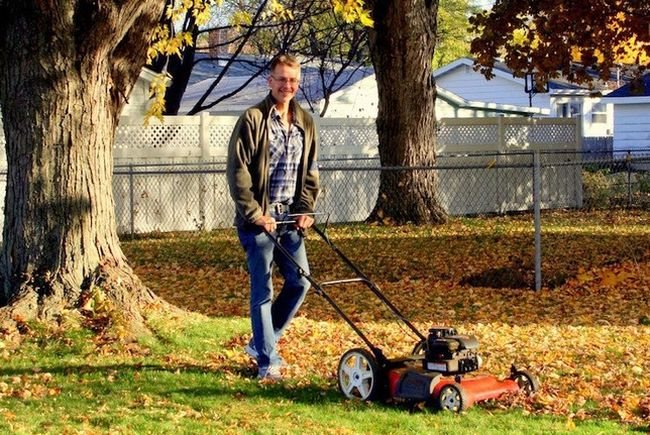

Abundant watering
It is important that the fruit trees do not dry out for the winter. If the fall is not rainy enough, water the soil well in the near-trunk circles. During the water-charging autumn watering, spend about 50 liters of water per adult plant. Water the trees in stages: approximately 12 to 15 liters per hour. The soil must become moist to a depth of approximately 1 m. Please note that the water temperature must be 5 ° C higher than the ambient air temperature outside.
After watering, mulch the tree trunks with peat, spruce branches, humus or compost. This will help retain moisture in the soil.
Why prepare the beds in advance?
This question is often asked: after all, there is spring, when you can have time to prepare the beds, and sow seeds, and plant seedlings. Yes, it is absolutely true, but, firstly, not all fertilizers will have time to go into a form accessible to plants, as we said above, and secondly, spring is such a fleeting period that in fact, you can simply not have time to do everything, as it is necessary. Remember the Russian proverb in the words of a peasant peasant: "Drop your hat in the spring - I won't lift it" (that is, so busy).
In addition, if we prepare the beds for winter in the fall, think for yourself how much we will ease the spring worries: all that needs to be done is to loosen ready-made beds, make holes for planting seedlings or furrows to sow seeds, and start carrying out the usual procedures related to shoots or seedlings, without rushing anywhere and without being late.
Autumn whitewashing of trees


To protect trees from pests and spring sunburn, whitewash the trunks down to the base of the lower skeletal branches. Use a ready-made whitewash (sold in garden stores) or prepare it yourself for this you will need: dilute 3 kg of lime and 500 g of copper sulfate in 10 liters of water.
Autumn whitewashing of the garden is carried out in October-November
Protecting trees from rodents
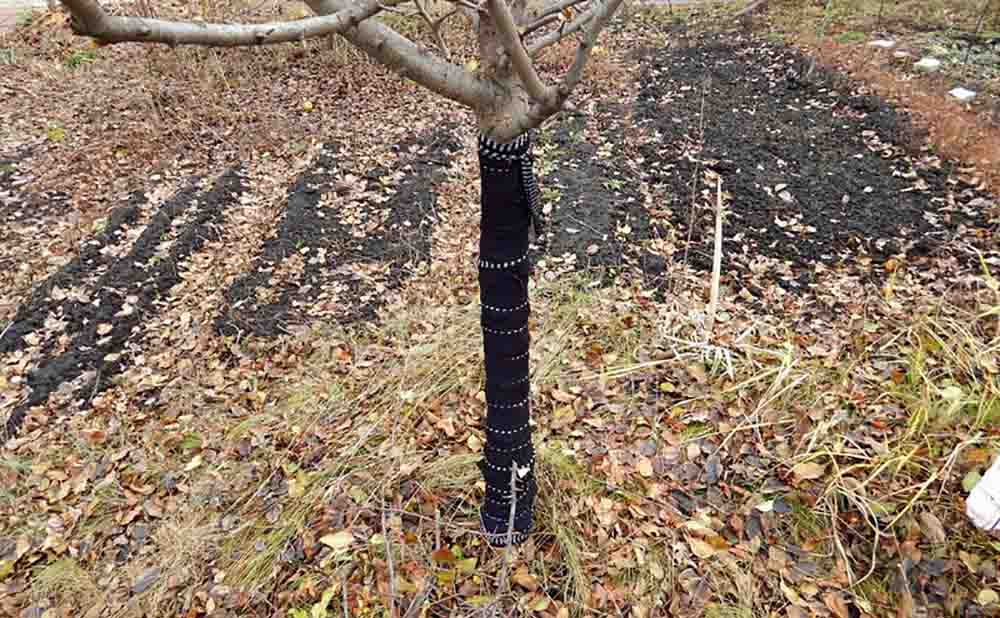

Hares and mice love to feast on the bark of fruit trees in winter. Rodents can cause serious damage to plants, especially young seedlings. To prevent this from happening, wrap the trunks to a height of 50 to 100 cm with nylon tights, roofing felt or cut plastic bottles.
How to properly prepare your garden for winter
Novice gardeners have a lot of questions related to autumn harvesting. Many people ask whether it is necessary to mow the lawn before winter, someone is wondering whether it is necessary to water the trees before winter. Let's try to answer the most frequent questions in order.
Is there a difference “how to prepare a garden for winter in the Moscow region” and “how to prepare a garden for winter in the Urals”? Yes, and it is necessary to understand and comply with all conditions.
- You need to pay attention to the timing. In the middle zone of the country, the garden can be started to clean in October or early November. Of course, if the early frosts did not begin. In the Urals, in Siberia, autumn work in the garden begins in September. And in the south of the country, the dates are shifted in the opposite direction.
- Warming plants for the winter. Of course, beyond the Urals, the climate is harsher, the frosts are harder.Therefore, young plants as well as frost-sensitive plants may die. They need to be covered very carefully. In the Krasnodar Territory, most plants do not need shelter. In Siberia, most horticultural crops need to be hidden under a covering material.
You may be interested in: What year does the pear bear fruit after planting?
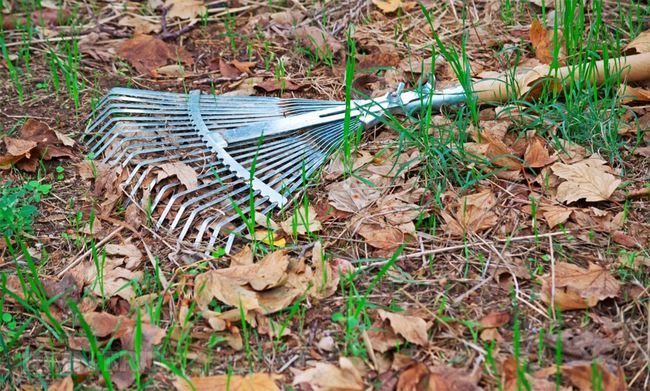

Digging the garden in autumn
Before the first frost and snow, the garden should be dug up - in the spring it will be easier to develop the beds. Do not do this after the rain - moist soil will quickly compress. The site is dug up shallowly, on a shovel bayonet, without breaking large layers - this way the soil will not settle.
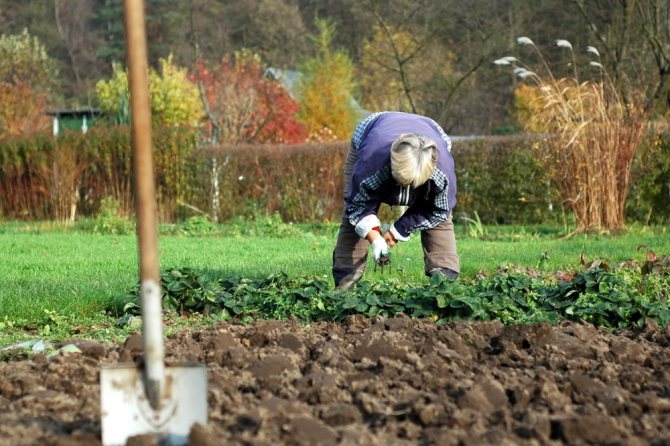

Digging the beds in late autumn will significantly reduce the number of harmful insects
When digging, weeds are removed, pests that have hidden in the ground for wintering are destroyed, the soil becomes loose and breathable. During the winter, the earth will be enriched with minerals introduced during digging, the snow will quickly saturate it with moisture.
Take notes
When cleaning your garden in the fall, think about what and how you have grown this season. Be sure to write down which plants you grew, which ones took root well and gave a lot of fruits, what kind of crop you harvested. What pests have you had to deal with this year? Were there any beds that upset you? Writing down these nuances now, with fresh memory, you will receive enough information for competent planning of the next summer cottage season. It also gives you time to find solutions to the problems you are facing.
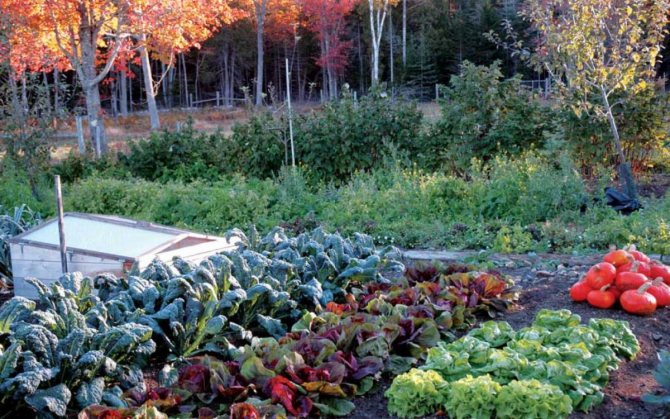

In hot pursuit, write down which plants you grew, which ones took root well and gave a lot of fruits, what kind of crop you have harvested. <>
Tips for beginners from experienced gardeners
Before the onset of cold weather, there is a lot to do: tidy up inventory, prepare a lawn and artificial reservoirs for wintering, disinfect greenhouses, and cover garden sculptures.
Lawn preparation
All fallen leaves should be removed from the lawn to prevent damping and bald spots. In dry weather, once a week, you need to moisten the lawn; when the temperature drops, stop watering. To stimulate root growth and increase frost resistance, top dressing is carried out with phosphorus-potassium fertilizer (30-50 g / m2), scattering the dry mixture over the grass.
2 weeks before frost, the last haircut is carried out at a level of 8 cm from the ground. Tall grass (more than 10 cm) will fall and rot during frosts, too short will freeze.
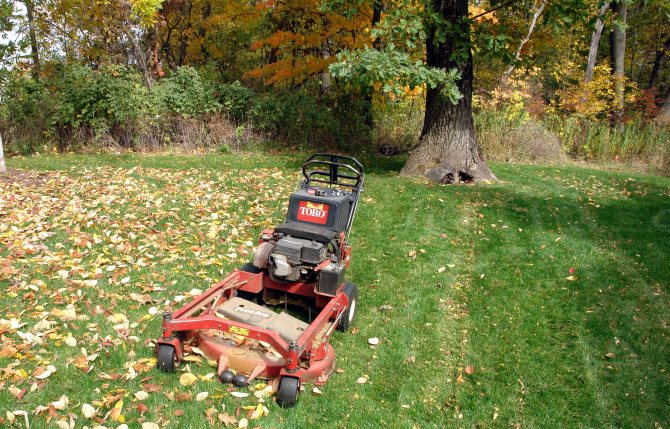

The optimal height to mow the grass during the last autumn cut is 8 cm
Tools required for planting.
Any gardener should have the necessary minimum of tools that will allow him to organize the beds.
First of all, this should include the tools for planning the site: a tape measure and a ruler. You may also need a building level if you want to equip a perfectly flat surface (for example, beds according to the Meatlider system).
For tillage you will need a bayonet and a shovel. A rake is also useful - for loosening the soil.
You also need to purchase a garden scoop. With its help, it is convenient to apply fertilizers.
If the area that needs processing is large, and the gardener is far from a beginner, you should think about purchasing a walk-behind tractor.
The listed tools are the most essential. There are a great many modifications of them. Each owner chooses for himself which of them to use.
A well-chosen tool can greatly facilitate the work of the gardener. It is very important to keep track of your inventory. As long as it's made from quality materials, you don't have to worry about changing it frequently.
To organize really competent preparation of the garden for planting, any owner must take into account many factors.He must be well acquainted with the biochemical composition of the soil, take into account the terrain, the peculiarities of the planted culture.
By strictly observing the rules for preparing the beds for planting, the gardener is able to achieve good results and an impressive harvest.
Tags: garden, garden, autumn, prepare
About
«Previous post
Gardening plan in the fall
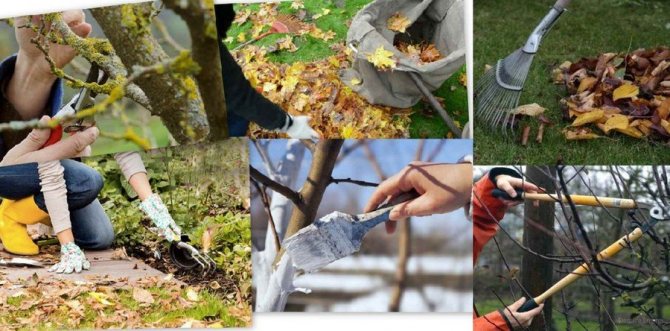

Proper autumn orchard care begins in September and ends two weeks before the first frost. In order not to miss anything, it is recommended to draw up a preliminary plan depending on the region of residence, and based on it, carry out all the relevant activities. The main actions for caring for a garden include:
- a carrion from the ground is collected, pests are destroyed;
- planting young seedlings in October, when there are frequent rains and a significant cooling is felt;
- pruning fruiting plants;
- whitewashing of tree trunks;
- carry out preventive work against fungus and rot;
- processing branches and trunks from insects hidden inside;
- collection of fallen leaves and cut branches, their burning;
- digging in trees;
- feeding and fertilizing plants.
If necessary, the plants are insulated and protected from rodents. Young seedlings should be especially carefully protected, as they are more exposed to the attack of rodents and pests.
Whitewashing of trunks


Whitewashing fruit trees in the fall is very important. It protects the plant from:
- From insects that lay their larvae, harm the plant.
- Protection against temperature drops. In the daytime, the bark warms up from the sun's rays, and at night and in the evening it is exposed to severe frosts.
- When the tree has not yet had time to be covered with leaves in the spring, the whitewash protects it from burns.
- Protection against fungal diseases.
Interesting!
The whitewash should be rich and thick. It covers the base of the trunk, and, if possible, the base of the skeletal branches. For young trees, chalk is used instead of lime.
The solution is prepared in several ways. The simplest solution is considered, which includes lime, copper sulfate and water. For 10 liters of water, you will need 2 kg of lime and 400 grams of copper sulfate. A little paste can be added to the solution to increase the viscosity, as well as cow dung or 1 kg of clay.
However, when caring for young trees, it should be remembered that paste is not used to whitewash them. It prevents air from reaching the bark. For young fruit trees, the solution is prepared from 1.5 kg of clay, 3 kg of lime and 1 kg of cow dung. All ingredients dissolve in water.
There is another option - the purchase of a ready-made mixture for whitewashing tree trunks. The mixture can be inexpensive and include clay and lime. However, it is washed off very quickly by rains and will need to be applied several times. But you can buy a more expensive drug - a mixture containing carbolic acid. This will not only allow the whitewash to stay on the trunks for a long time, but also protect against various rodents and hares.
Sanitary pruning


Trees should be pruned at least twice a year - in spring and autumn. In the fall, bushes and trees are pruned before frost, when all the foliage has already fallen. However, do not overdo it, as over-pruning may not benefit, but harm the tree.
The most straightforward pruning involves removing dried out branches or branches that have been affected by the disease. To prevent contamination of other fruit trees and shrubs, such branches are recommended to be burned outside the garden. If the branch is dried up, no harm is done to the tree when it is removed. If it was necessary to cut off a process that is sick, then the cut site must be treated with linseed oil or oil paint, since these branches are considered still alive.
The main goal in this procedure is to improve the flow of air and sunlight along the entire crown.Thanks to sanitary pruning, the correct formation of the crown occurs, since excess branches, and those that grow down or towards the crown, are removed. Those branches that intersect with each other are also subject to removal. To maximize the sun's rays for the tree, the branches should be evenly distributed on all sides. Pruning branches is also considered an important procedure. This makes it easy to set the correct growth direction.
Preventive treatment of the garden from diseases
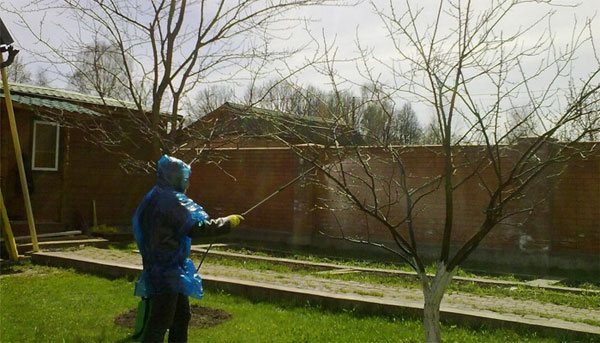

For various diseases, fruit shrubs and trees are treated with special medicinal substances. As a prophylaxis for various spotting, drugs are used that contain copper, a solution of copper sulfate or Bordeaux liquid. Prophylaxis with fungicides such as Topsin is possible. Horus or Cuproxat.
Such medicinal substances as Strobi, Impact or Skor allow you to get rid of the occurrence of rot or scab. If cracks or any other wounds have formed on the bark, then they must be treated with five percent copper sulfate. After processing, they are covered with cement.
With special iron brushes, they clean the branches and trunks from dead bark, since the larvae of apple moth, silkworm and other insects hide in it.
Autumn feeding


Autumn care for adults and young trees also includes top dressing. It is very important, as it provides the plant with high immunity, due to which it will be able to withstand severe frosts and increase fruiting in the new season. Top dressing is applied at the moment when the trunks are being dug in.
There are two types of fertilizers in the fall:
- Humus.
- Phosphate-potassium fertilizers.
Humus is added depending on the age of the tree. If he is less than 8 years old, then 30 kg of humus is enough, if older, then from 50 kg. By the spring, the substance will have time to overheat and the plant will receive the necessary portion of the nitrogen supplement.
Interesting!
Nitrogen activates the movement of sap in the plant, which violates its winter hardiness. Therefore, it is recommended to apply nitrogen fertilizers not in autumn, but in spring or summer.
Monopotassium phosphate is considered a popular phosphorus-potassium fertilizer. It is composed of 34% potassium and 54% phosphorus. This drug is absorbed by the whole plant. However, it is expensive, so it is recommended to apply it to very whimsical crops.
Potassium preparations include chloride and potassium sulfate. It is better not to treat bushes with potassium chloride, as it is capable of oppressing them. Potassium chloride does not cause a negative result on trees. Potassium sulfate is suitable for feeding both trees and bushes. For one square meter, it needs from 5 to 10 grams.
Ammophos and superphosphate are considered popular phosphate fertilizers. Superphosphate is more preferable for autumn feeding, since nitrogen is present in ammophos.
Features of caring for seedlings of fruit trees in autumn
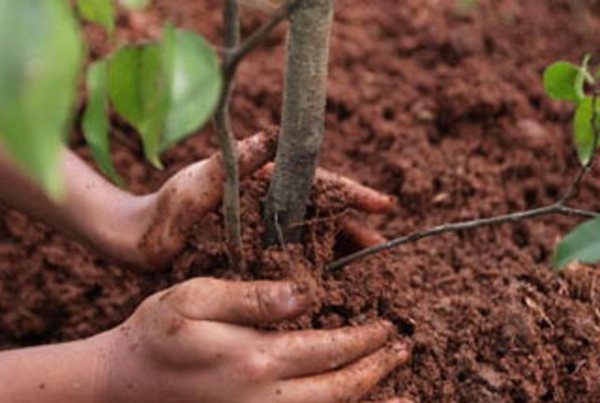

Care for young trees after planting consists in mulching the soil and tying to a support (stake). To avoid damage to the root system, digging is carried out carefully to a maximum depth of 15 cm.
The young bark of seedlings is very attractive to mice and hares. To protect a young plant from attack, you need to hide the bark of the tree under a special covering material. A simple mesh with small cells can be used as a covering material. You can also use regular synthetic stockings and tights.
Protecting the garden from insects
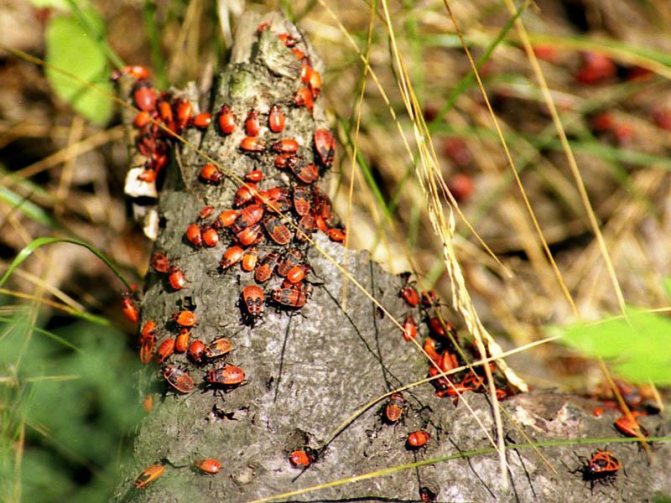

The bark of the tree serves as a comfortable place for overwintering a variety of insects. They can lay their larvae in the bark, in the nests of the crown, as well as in fallen leaves. To protect your garden from insects, follow these steps:
- Clearing foliage and other debris from the entire garden. Use a special iron brush to clean the bark of the tree.And to destroy the wintering of caterpillars in the soil, dig up the soil 15 cm deep.
- It is good to inspect all plants. Cracks and abrasions in the bark of trees should be treated with 5% copper sulfate and lubricated with cement.
- Spray the garden with a solution of urea (3 or 5%), as well as preparations that contain copper.
These manipulations will protect the garden from such popular insects as the stalk, silkworm, aphid or lungwort.
Protecting the garden from rodents
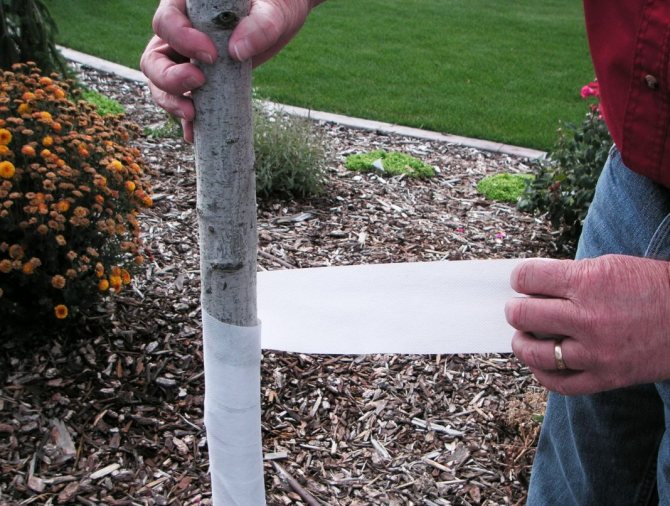

Garden trees and shrubs are very easily attacked by various small rodents and hares. For protective purposes, the trunk is wrapped in cloth. For example, it can be burlap or old rags with roofing felt.
Interesting!
In order for the tree not to stifle, when wrapping it with matter, burlap or rags are placed under the roofing material.
And so that mice do not get to the trunk, the matter that covers the tree must be well buried with earth at the base. The garden can also be protected from small rodents with the help of pine or spruce branches. They are placed in the periosteal circle and the trunk is tied. Mice can also be scared away by sprigs of coriander. If they are scattered near a tree, then mice may be intimidated by their smell.
Watering garden trees


Before wintering, it is recommended to water the garden only in those regions where there is little rainfall. With normal humidity in the region, watering is recommended in October, but not later.
Watering in the fall, together with earthing up the base of the plant, instead of benefit, can harm the tree. Therefore, hilling of trees is allowed only in regions where there is little snow and severe frosts.
The last watering before winter charges the tree with moisture and strengthens its root system. In winter, the roots are able to receive moisture from a depth of 1.5-2 meters. In addition, watering before wintering improves the growing season, replaces watering in the spring, and also protects the tree from sunburn.
When watering, it is important to remember that excess moisture is just as dangerous as lack of moisture. If the tree does not have enough moisture, then it will not be able to develop immunity to severe frosts. On average, 10 to 16 wind of water is enough for one square meter.
Digging a tree


Asking the question: is it necessary to dig trees in the fall, inexperienced gardeners believe that this can be transferred to the spring. However, the autumn digging is irreplaceable and very important. With its help, the larvae of harmful and dangerous pests die, the soil is saturated with oxygen, and the seeds and roots of various weeds are decomposed.
Digging must be done no later than October. The root system of young seedlings is shallow, so deep digging is not recommended for them. The location of the root system depends on the variety of the fruit tree. For example, in an apple tree, the roots are in a radius of 20 to 60 cm around the trunk, in a plum - from 20 to 40 cm.
In order to prevent the ground from frosting over and weathering, it is necessary to dig in fruit trees carefully and not break large lumps of earth. Digging up the ground in late autumn is also not recommended, since early snow will not allow the ground to warm up well and quickly in the spring.
Harvesting leaves
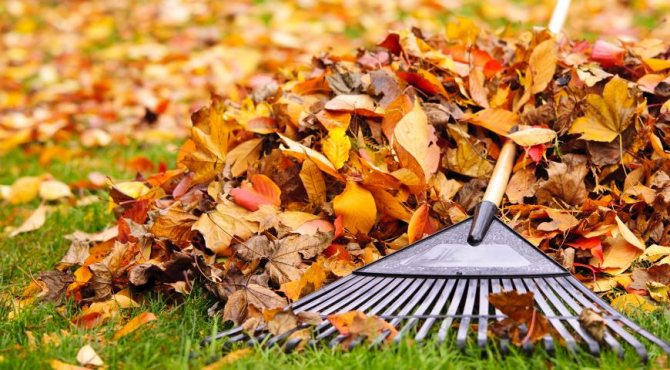

In the fall, when caring for fruit trees, it is also important to do leaf harvesting. Various insect or pest larvae hide in the leaves for the winter, and the remnants of disease spores are also possible. This must be taken into account when cleaning the garden.
If the site has not been exposed to various diseases, and pests have not attacked it, then fallen leaves can serve as a good fertilizer. To do this, you need to collect all the foliage in bags, and in the spring pour it into one heap for rotting. During the winter, all harmful microorganisms, if they remain in the foliage, die in frost. If fallen leaves are susceptible to attacks by pests and various diseases, then such foliage should be collected and burned.
Test your soil
Autumn is a great time to do a soil test to determine if it needs additional nutrients and pH adjustments. The results of such a test will contain the following information:
- soil pH;
- levels of potassium (K), phosphorus (P), calcium (Ca), magnesium (Mg) and sulfur (S);
- organic material content;
- lead content.
This information will help you determine how much lime and fertilizer (organic or mineral) you need to add to improve the condition of the soil. Lime is commonly used to adjust the pH level. Adding it in the fall is a particularly good solution, as it will completely dissolve in the soil during the winter. The rest of the additives designed to adjust its composition are best applied in the spring.
Clean all the beds well
By the end of the season, the vegetable garden is usually in such a mess that you might just get discouraged. Break a large task into several small ones and clean up at least one garden bed at a time, until they are all cleaned and prepared for winter.
Be sure to remove any dead plants. Some diseases, including late blight, as well as pests, may well overwinter on foliage and rotten fruits left in the garden. Therefore, remove all dead vegetation and all rotten fruits or vegetables. You can add healthy plant material to your compost. However, keep in mind that, more often than not, the compost heap is not warmed up enough to eradicate disease or fungus. Therefore, unhealthy plant residues affected by disease, pests or mold are best disposed of with household waste or burned to prevent these problems from spreading to the entire compost heap.


Be sure to clean your garden well after harvest. <>
Harvesting and storing
It is necessary to harvest vegetables, berries and fruit crops on time and correctly. The materials on our website will help you with this (about the collection time and storage methods):
- potatoes - when to dig and how to store;
- beets - harvest time and storage rules;
- carrots - harvest time and harvest storage methods;
- radish -when to dig and store properly;
- celery;
- sweet and hot pepper;
- eggplant;
- horseradish roots;
- cabbage - harvest time and ways to store it;
- garlic - when to clean and how to store;
- Luke;
- pumpkins - collection time and storage methods;
- pears;
- collection, drying and storage of rose hips;
- on the timing and methods of harvesting sea buckthorn;
- walnuts;
- watermelons.
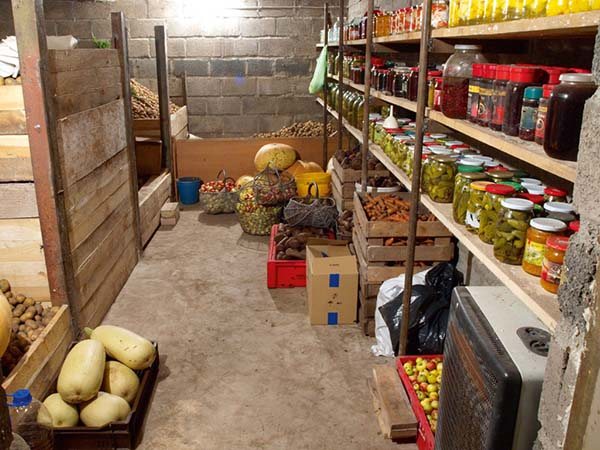

Expand your vegetable garden
Autumn is also a great time to expand your garden. Consider building several tall beds or a few square meters of vegetable garden right on top of the grass. Many garden hypermarkets run organic soil and compost sales ahead of the end of the summer cottage season.
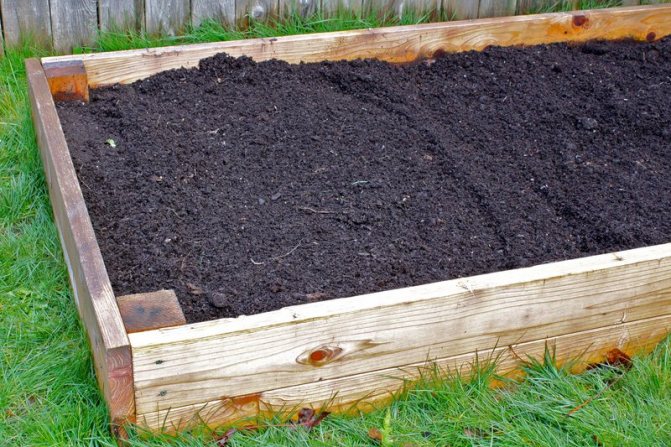

A garden bed prepared in the fall will save your strength and time in the spring.
Mulching
Mulching in the fall is an important step in growing your own vegetable garden. This measure allows you to give the soil the necessary amount of important organic substances, which will allow the land to have high fertility for a long period. It is the autumn period that is most favorable for this process. The crops have already been harvested, and there is a lot of organic waste on the ground.
Tops, vegetable and fruit residues, and other natural waste should not be removed from the soil. Add sawdust, leaves, plants on top of it all and cover it all with cardboard. If there is no complete thick sheet, then you can use cardboard boxes. This method of mulching will protect the earth from the cold, and also allow it to become healthier.
Fruit trees can be insulated with mulching. For this, the same organic waste is used. They are able to protect tree roots from cold conditions.However, you should not use dry grass, as rodents can start in it. For each of the listed measures, you can find a video instruction that will help you to carry out the activities correctly.
Pre-sowing measures for various crops
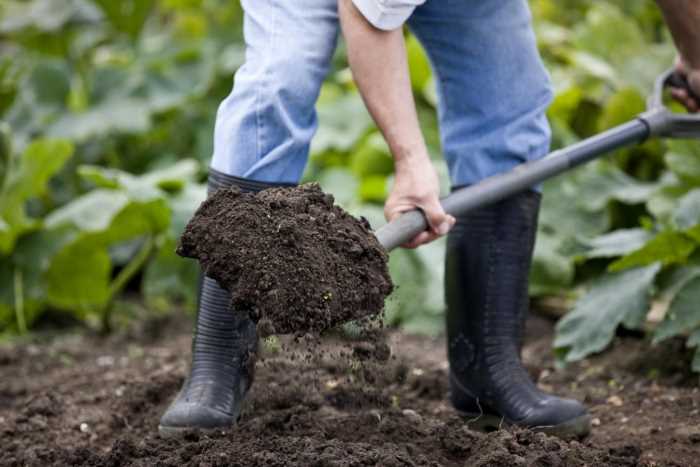

For planting different crops, the soil is prepared in different ways.
We suggest you familiarize yourself with: There is a lot of vinegar in pickled cabbage what to do
For example, carrots require very thorough loosening of the soil. It germinates well only on porous soil. Insufficient digging will lead to the emergence of small, ugly root crops.
At the stage of loosening, it is worth adding fertilizers that are suitable specifically for carrots. Mixing soil with ash is a good choice. This is an old and completely free way to increase the yield of carrots.
To protect it from pests, future beds are best planned in places where tomatoes, onions or garlic used to grow.
To get a good harvest of garlic, you need to choose the right place for planting it. It should be a well-lit and warmed area where water does not stagnate for a long time.
There are crops that are planted in the fall. Plants planted before winter require special preparation of the soil cover:
- When planting winter garlic, choose a garden bed on the south side of your garden with fertile, acidic soil. For 1 m², add 8-9 kg of humus and 1 glass of wood ash. Do not plant the plant immediately after digging: the soil will settle and the likelihood of seedlings will decrease. The day before planting, water the bed with urea or nettle decoction.
- Plant onion sets in sandy, moist soil. Cover the top of the bed with a layer of dry peat or manure to prevent the culture from freezing.
- Treat the soil for planting calendula and cosmos with a soapy solution from pests. Do not make the garden bed narrow: the flower seeds will freeze and will not sprout in the spring.
- Fertilize the land for sowing herbs with phosphorus and nitrogenous fertilizers. Basil and cilantro prefer moist soil, while parsley prefer dry soil.
Moisten the soil for sowing before winter 2-3 days before planting. Otherwise, the seeds will be supercooled and will not sprout.
Proper preparation of the beds in the fall will ensure the complete restoration of the soil structure. To get a rich harvest, plant winter-hardy varieties of crops before winter.
Caring for fruit trees in autumn
The harvest of the next year largely depends on the activities carried out in the fall. Therefore, do not send trees for the winter in an unkempt condition.
Remove old dead bark, moss and lichens. The larvae of pests like to hibernate under them, so in the spring it is important not to leave insects a single chance. Also, remove all trapping belts. Disposable (paper) - burn, and fabric - wash, dry and put away until spring.
Pruning trees
Prune fruit trees before frost in dry weather. Use a sharp pruning shears or garden saw to completely remove dry, damaged, diseased and growing branches. Then treat the sections with a solution of copper sulfate (dissolve 1 tsp of the substance in 1 liter of water) and cover with garden varnish or oil paint.
Treatment against diseases and pests
After the leaves fall, proceed to the autumn processing of the garden. If you notice signs of mold on the trees, spray the plants with a 3% solution of Bordeaux liquid. To get rid of the causative agents of coccomycosis, scab, powdery mildew and other common diseases, treat the crowns with urea (0.5 kg of urea per 10 liters of water). Also spray the soil around the trees, only with a more concentrated solution (1 kg of urea per 10 liters of water).
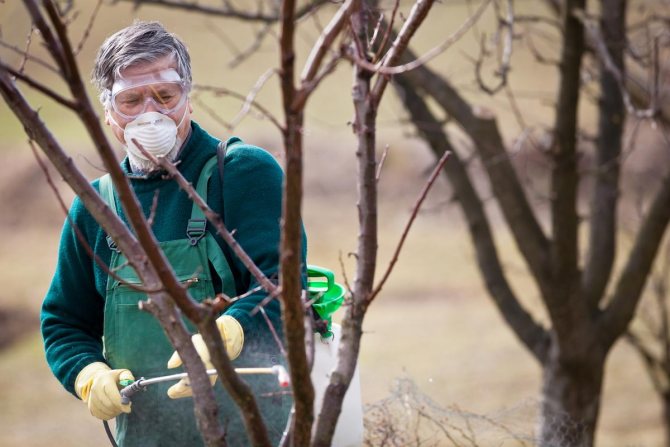

Urea treatment helps to eliminate pests that winter in the topsoil and on tree branches
In the fight against pests, loosening the soil with a pitchfork in the near-trunk circles to a depth of 20 cm helps.After this procedure, insect larvae find themselves on the surface of the earth and die during severe frosts.
Sowing siderates
Green manure is an effective organic fertilizer and good maintenance of the vegetable garden in the fall. Most often, they are planted on the beds in the fall, when the crop is harvested. Siderata not only enrich the soil with useful microelements, but also protect it from weeds. For this, plants are used that have a powerful root system and quickly gain green mass.
As siderates, plants from the legume family are often planted: lentils, lupines, alfalfa. It can also be winter rye or wheat, mustard, amaranth, buckwheat, etc. Plants planted as green manure not only increase soil fertility and make it loose, but also protect the soil from scab, various rot and insects living in the soil.
After mowing, the plants can be used as mulching material.
Winter green manures allow you to retain snow on the beds, which provides the soil with the necessary moisture.
When planting siderates in an autumn garden, it is necessary to remember the main principle of crop selection: the same garden bed cannot be used several times to grow plants belonging to the same family. This means that rapeseed, which belongs to the cruciferous family, cannot be planted in the garden after or before cabbage.
When the green manure grows up to 20-25 cm, they are mown. This must be done before the seeds appear, otherwise useful plants will become uncontrollably growing weeds in the next season. Green stems are embedded in the soil. When decomposing, they, like the roots remaining in the ground, will enrich the soil with useful substances.
Siderata planted in the garden before winter and mowed in spring can be left in the beds for several weeks. This mulching of the soil will accelerate the decomposition of the root system remaining in the soil.
Composting
First you need to prepare the compost pit. It is best to fill it in the fall, when there is a lot of organic waste on the site. At the bottom of the pit, it is necessary to decompose the organic matter of long decay - these are large tree branches and other wooden waste. This first layer can be covered with food waste and cut grass, faeces and herbaceous vegetable residues. The top is covered with a layer of fallen leaves, then with earth and watered with a solution of drugs with effective microorganisms (EM - drugs).
After that, you can decompose a layer of any paper waste - newspapers, magazines, cardboard. Then again food waste, grass and tops of vegetable crops, leaves and a small layer of earth, and on top of it there is a little EM-preparation.
When the compost pit is completely filled with such layers, then it should be covered with plastic wrap on top and left until the compost matures (until spring). He is not afraid of winter frosts and cold weather. Until spring, the bacteria will do their job.
Cleaning tools and equipment
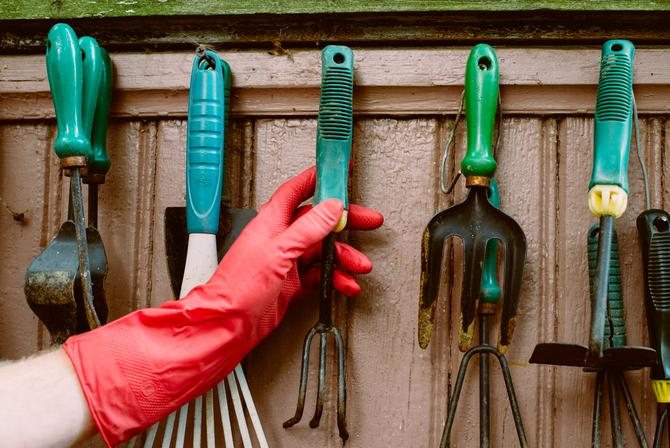

This is another important stage of the autumn work. At the end of work in the garden, you need to free all containers from the water and turn them upside down. All gardening equipment must be carefully inspected and, if necessary, washed, dried, cleaned, sharpened, lubricated. During the spring sowing period, there will not be enough time for this.
In the fall, you need to take care of harvesting seeds and replenishing the supplies of drugs necessary for the garden (for example, a remedy for diseases and pests, laundry soap, soda, salt, tar).
Having worked hard in the fall, you can make your work much easier in the spring.
The richer you have harvested, the poorer the land in the garden has become. Therefore, in the fall, it is necessary to increase fertility and improve the structure of the soil. We will tell you about soil cultivation technology.
With proper autumn tillage, surface loosening will be sufficient in spring. Therefore, before the beginning of winter, it is necessary to have time to carry out all the main measures to prepare the garden for wintering.
Garlic shelter materials
In the central part of the country, garlic is planted most often in the last week of September or in the first two weeks of October. It is not recommended to plant garlic later, the cloves will die during the first frost, especially in the absence of snow. The cloves dug in early can grow, and this is unsafe, the germinated plant does not tolerate cold well. Planting the garlic too early can prevent the harvest of winter garlic from happening.
If you are late with planting, it is better to use the following planting method, in which you can plant the date before October 15, if the ground is already very cold, you need to water the soil with warm water. It is necessary to soak the cloves in a humate solution for several hours. Then moisten the sawdust solution, sprinkle the cloves with them. Having removed the planting material in a warm place, after 2 days you can see the first roots.
Different regions use different materials to shelter garlic for the winter. Among the most versatile materials that can be used:
- Agrofibre.
- Peat.
- Sawdust.
- Fallen leaves.
- Plant stems.
As soon as the garlic is planted, the beds are mulched with a small amount of sand and ash. Serious shelter will be required when the weather worsens, forecasters predict frosts. The timing of serious warming depends on the climatic conditions of the region. This happens in mid-November, if we talk about the middle zone of the country. How to cover garlic for the winter?
Agrofibre is a modern covering material. It appeared not so long ago, but has already managed to establish itself on the positive side. Agrofibre is a thin film of polypropylene. Its other name is spandbod. The advantages of such a shelter include the fact that excess moisture does not accumulate under this film, unlike ordinary polyethylene.
Agrofibre does not allow garlic to freeze in winter, it transmits light well. As soon as the snow melts, the film will act as a kind of greenhouse. In warm regions, it is enough to cover the plantings of garlic with agrofibre only to prevent the soil from freezing. For the middle zone, as well as for the northern regions, one agrofibre will not be enough. In Siberia, roofing sheets are additionally used, laid on spruce branches.
The disadvantage is that agrofibre is a relatively expensive covering material, but it is worth it. Indeed, with careful handling, you can use the film for 4-5 seasons. It is easy to cover the beds for them. Cover the bed with a film, sprinkle the edges with soil, press down in the corners with stones. Shelter timing, as with any other covering material.
Peat application
Peat retains heat well. The teeth will be reliably protected even during the most severe frosts. Excess moisture does not get under the peat layer. Peat is scattered on the beds in a layer of 3-4 centimeters.
The disadvantage of this material is that peat increases the acidity of the soil. The soil, saturated with peat moisture, forms a hard crust in the spring, preventing the garlic from germinating.
We suggest that you familiarize yourself with: Pumping station for a well what you need to know
Sawdust is a very popular method for covering garden beds. The advantages of using sawdust include a high level of thermal insulation. This material retains and absorbs moisture well. For soil, sawdust is an excellent material.
But there is also a drawback. Sawdust has poor air permeability at high humidity. Under the sawdust, the soil is oxidized, and they also make it difficult to warm the earth in spring.
Fallen leaves
Some gardeners, who have a lot of deciduous trees on the site, prefer to use fallen leaves as a covering material. A layer of fallen leaves is laid on the garden bed, and a layer of snow will fall on it. The leaves are breathable. But with a sharp change in temperature, high humidity, the layer freezes up, air permeability is immediately lost, the plant simply decays and rots under such a cover.Various insects and mice prefer to spend the winter in fallen leaves, which can harm garlic and infect it with various diseases.
Plant stems
It is good to insulate garlic with the stems of various plants. It is necessary that the stems be without inflorescences and seeds. Such material is capable of trapping snow, creating a natural snow cover. The soil will not get much wetted under such a layer. The disadvantage of dry stems is that they are susceptible to mold and rot, which can make the crop sick.
Preparing beds for certain crops
Above, we examined the general rules for preparing the beds. As you already understood, all work is carried out quickly and simply: you just need to clean the area, dig it up so as to outline the edges of the future bed. Now it's time to talk about how to prepare a garden for vegetables, which are grown by almost all gardeners.
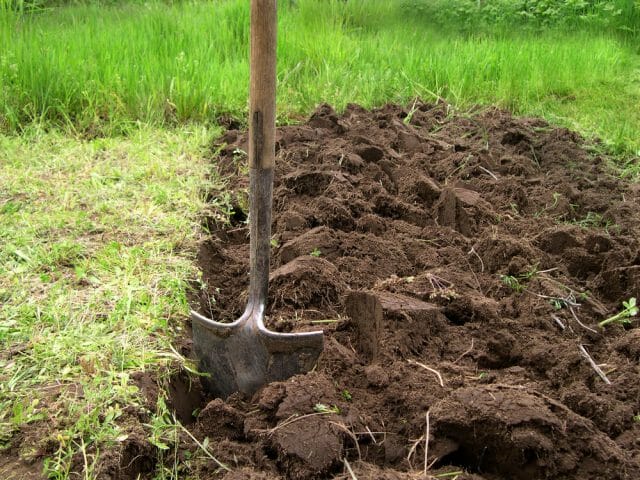

Cooking a garden for vegetables
Beet beds
Do you want to harvest a rich harvest of table beets? Take care of preparing the garden in the fall. Choose a well-lit area with loose and well-drained soil for this vegetable crop. It is recommended to prepare a place for beets on sandy loam and loam with a neutral pH level. Heavy loamy soil is not suitable for beets. It will grow poorly on it, even if you provide it with full nutrition. It is also important to keep away from the place where there is accumulation of melt, irrigation and rainwater. The same goes for areas with acidified soil.
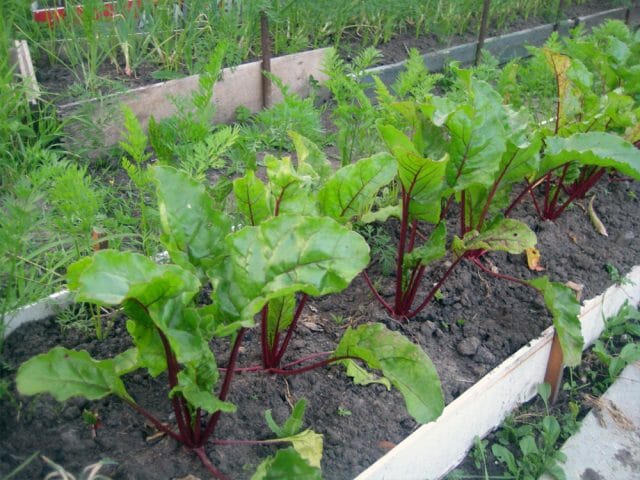

Beet beds
It is recommended to plant beets in the beds that were previously occupied by potatoes, zucchini, early ripe peppers, eggplants, cucumbers, tomatoes.
Arrangement of warm beds and trenches
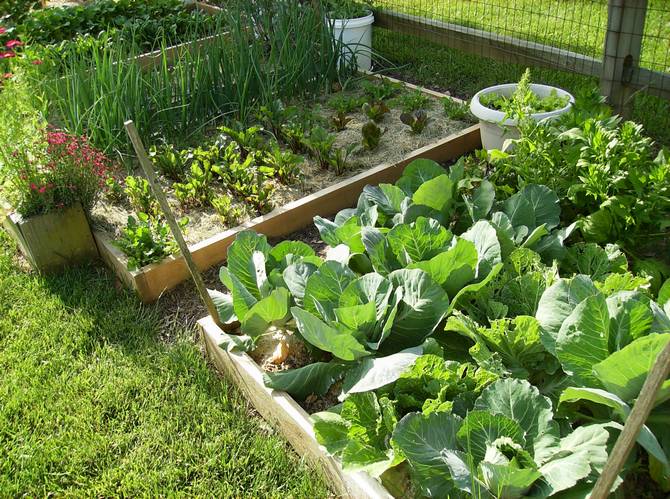

If the compost pit is full and organic waste still remains, then consider building organic trenches or warm beds. For their improvement, all the organic materials and waste that can be in the garden or in the summer cottage are just needed. And such trenches and beds are useful for growing various vegetables. They will provide favorable conditions for growth and large yields.
Details about the device of a warm bed


